
Decoding the Language of the Hand
with Scientific Research!
This article presents a framework to discover the language of the hands based on Multi-Perspective Hand Reading. The framework serves to demonstrate how the use of specific 'hand sign combinations' can be applied to 42 specific diagnostic themes - including: 26 syndromes, 4 medical disorders, 2 psychiatric disorders & the 10 poles of the Big Five personality dimensions).
The first section presents a table featured with all 42 themes (displayed horizontal in 7 diagnostic categories) plus 56 major hand signs (displayed vertical in 6 hand level categories).
All labels inside the table are indicative for an unusual prevalence relative to the general population; labels featured with a golden square are indicative for very high diagnostic impact.
Labels featured with a '+' sign represent positive correlations; labels featured with a '-' sign represent negative correlations.
The final section (below the table) presents for each theme a quick summary of the various hand levels where the most significant hand signs are found for that specific theme. For many themes a 'phantom picture' is also available, which serves to summarize the most typical hand sign combinations for that specific theme in a visual format.
NOTE: A summary of all 56 major hand signs is presented in the SUPPLEMENT of this article!
- Summary of contents: 42 diagnostic themes! -
• TRISOMY SYNDROMES:
» [1]: Tr.21 = trisomy 21 (= Down syndrome)
» [2]: Tr.18 = trisomy 18 (= Edwards syndrome)
» [3]: Tr.13 = trisomy 13 (= Patau syndrome)
» [4]: Tr.8 = trisomy 8 (= Warkany syndrome)
• DELETION SYNDROMES (& 5p+ syndrome):
» [5]: 4p- = 4p- syndr. (= Wolf-Hirschhorn syndr.)
» [6]: 5p+ = trisomy 5 (= cri-du-chat anti-syndr.)
» [7]: 5p- = 5p- syndrome (= cri-du-chat syndrome)
» [8]: 15q- = 15p- syndr.(= Prader-Willi syndr.)
» [9]: 18p- = 18p- syndr. (= de Grouchy syndr. 1)
» [10]: 18p- = 18q-syndr. (= de Grouchy syndr. 2)
• SEX CHROMOSOME SYNDROMES:
» [11]: XO = Turner syndrome
» [12]: XYY = Jacobs syndrome
» [13]: XXY = Klinefelter syndrome
» [14]: XXYY = XXYY syndrome
• OTHER SYNDROMES:
» [15]: Acho = achondroplasia
» [16]: AMC = arthrogryposis
» [17]: CDL-s = Cornelia de Lange syndrome
» [18]: FA-s = fetal alcohol syndrome
» [19]: Fra-X = fragile-X syndrome
» [20]: HO-s = Holt-Oram syndrome
» [21]: KM-s = Kabuki make-up syndrome
» [22]: M-s = Marfan syndrome
» [23]: R-s = rubella syndrome
» [24]: RT-s = Rubinstein-Taybi syndrome
» [25]: SLO-s = Smith-Lemli-Opitz syndrome
» [26]: W-s = Williams syndrome
• MEDICAL DISORDERS:
» [27]: Diab-M = diabetes mellitus
» [28]: HypC = hypercalcemia
» [29]: Psor = psoriasis
» [30]: Rheu-A = rheumatoid arthritis
• PSYCHIATRIC DISORDERS:
» [31]: ASD = autistic spectrum disorder
» [32]: Schiz = schizophrenia
• BIG FIVE PERSONALITY DIMENSIONS:
» [33]: A+ = High Agreeableness (= agreeable)
» [34]: A- = Low Agreeableness (= antagonistic)
» [35]: C+ = High Conscientiousness (= conscient.)
» [36]: C- = Low Conscientiousness (= casual)
» [37]: N+ = High Neuroticism (= emot. sensitivity)
» [38]: N- = Low Neuroticism (= emot. stability)
» [39]: E+ = High Extraversion (= extraverted)
» [40]: E- = Low Extraversion (= introverted)
» [41]: O+ = High Openness (= open)
» [42]: O- = Low Openness (= closed)
NOTE: The table below presents a quick overview describing the significance of 56 hand signs in 42 conditions; the table also serves as an opportunity to check (or rule out) instantly whether a specific 'hand sign combination' might bare significance for multiple themes!

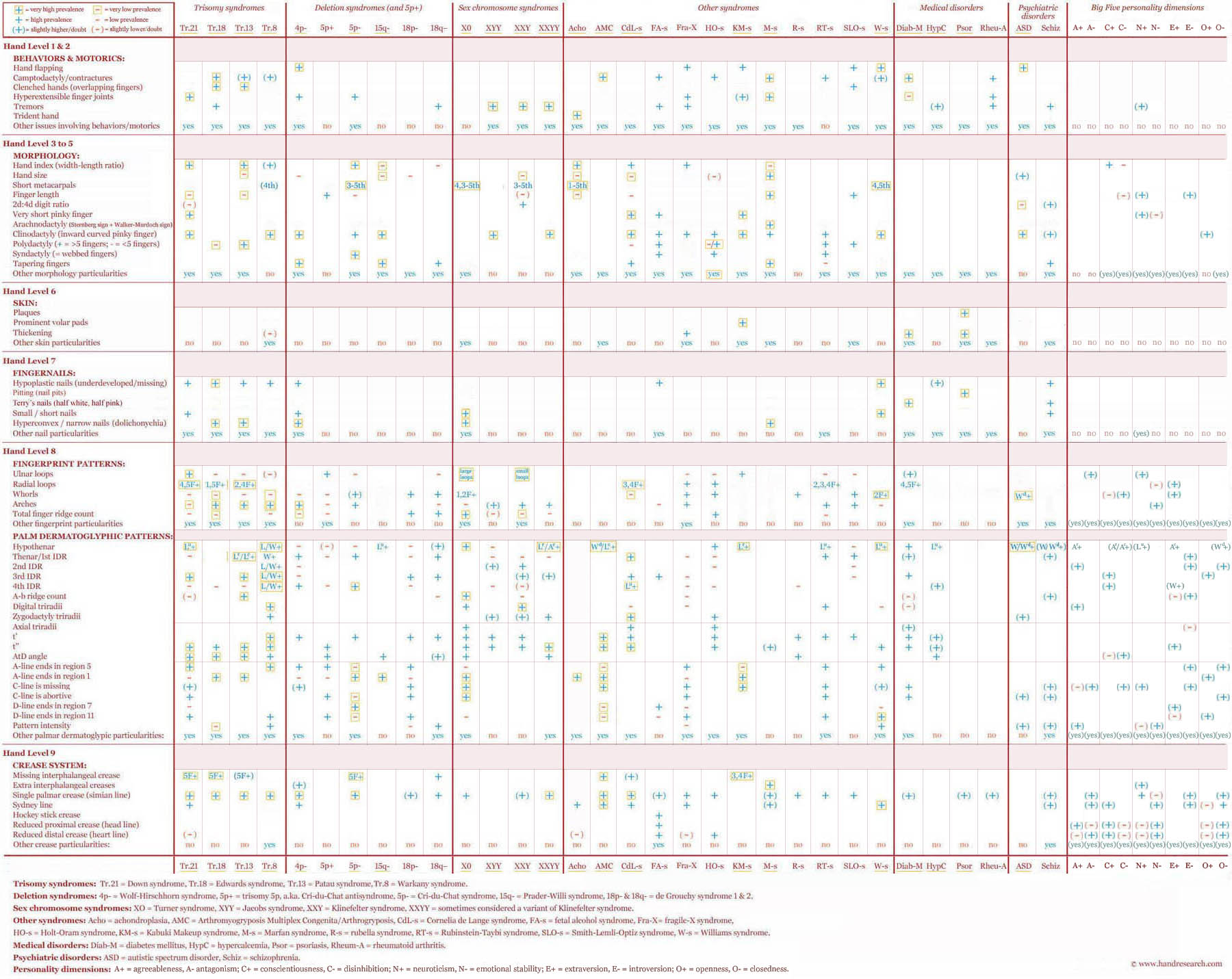
TIP: In order to find highly significant hand sign combinations for a specific condition, a 1st strategic step is to strive to get multiple perspectives of the hand included; a 2nd strategic step would be to strive for getting both the palm and the fingers included. For far most conditions both steps are required to make sure that an accurate assessment is made; more details on the significance of this fundamental issue are outlined in the previous section: Multi-Perspective Hand Reading.
- 4 Trisomy syndromes -
• [1]: Trisomy 21 (= Down syndrome):
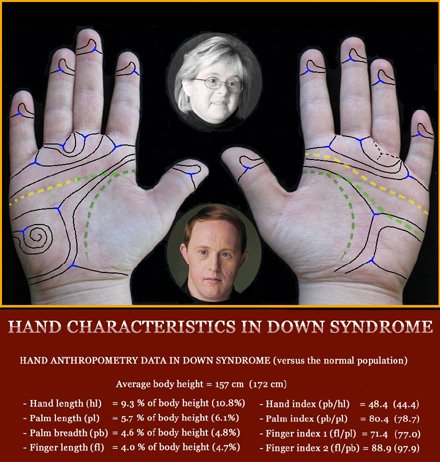
Typical hand characteristics in Down syndrome.
Summary of the most significant hand signs in Down syndrome:
- Hand level 2: hyperextensible finger joints.
- Hand level 3: short, broad hands.
- Hand level 4: broad palm.
- Hand level 5: short fingers, very short 5th finger, clinodactyly of the 5th finger.
- Hand level 8: usually all- or the large majority of fingerprints display an ulnar loop (10 likewise fingerprint patterns represent 'monomorphic hands'), often a radial loop is found on the 4th finger and/or 5th finger; the palm typically bares a pattern in interdigital zone 3 + the hypothenar, with the latter usually featured with a high positioned axial triradius (featured with a high AtD angle) often combined with an ulnar loop.
- Hand level 9: single palmar crease (a.k.a simian crease), single interphalangeal crease on pinky is sometimes present.
More details on the hand in Down syndrome are available here:
» Phantom pictures for the hand in Down syndrome
» 32 Hand signs in Down syndrome
• [2]: Trisomy 18 (= Edwards syndrome)
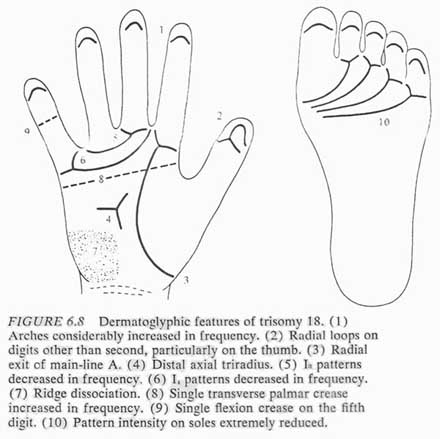
Phantom picture for the hand (& foot) in Edwards syndrome.
Summary of the most significant hand signs in Edwards syndrome:
- Hand level 2: clenched hands/overlapping fingers are seen in a very large majority of cases.
- Hand level 5: hypoplastic/missing thumbs are seen in a large majority of cases.
- Hand level 7: hypoplastic nails are seen in a large majority of cases, and hyperconvex nails are very common.
- Hand level 8: arch fingerprints are often present in all 10 fingers, if not a radial loop may be present on the thumb and/or pinky; whorls are quite rare. The palm usually has a loop in the 3rd IDR, and often a loop is also present on the thenar/1st IDR; the A-line ends in a very large majority of cases at radial side of the wrist; a high positioned axial triradius (t") is typically present, featured with a high AtD angle.
- Hand level 9: single palmar crease (a.k.a simian crease), single interphalangeal crease on pinky in a majority of cases.
More details on the hand in Edwards syndrome are available here:
» Phantom pictures for the hand in Edwards syndrome
• [3]: Trisomy 13 (= Patau syndrome):
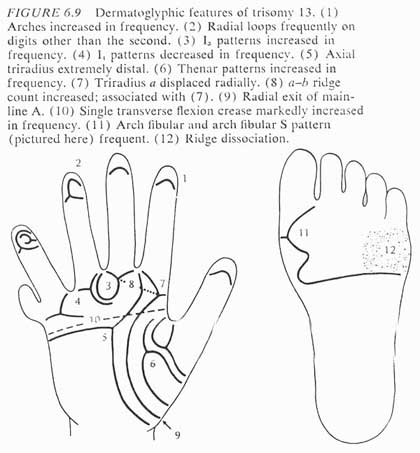
Phantom picture for the hand (& foot) in Patau syndrome.
Summary of the most significant hand signs in Patau syndrome:
- Hand level 2: clenched hands/overlapping fingers are seen in a large majority of cases.
- Hand level 3: small, broad hands with short fingers are typical.
- Hand level 5: extra fingers (polydactyly) is present in a large majority of cases.
- Hand level 7: long, hyperconvex nails are present in a large majority of cases.
- Hand level 8: radial loops are often present on the 4th finger and 2nd finger, combined with mostly arches and ulnar loops. The palm usually has a loop in the 3rd IDR, and often a loop is also present on the thenar/1st IDR; the A-line ends in a very large majority of cases at radial side of the wrist; an extremely high positioned axial triradiius (t''') is very often present, featured with an extremely high AtD angle (often above 90 degrees).
- Hand level 9: single palmar crease (a.k.a simian crease).
More details on the hand in Patau syndrome available here:
» Phantom pictures for the hand in Patau syndrome
• [4]: Trisomy 8 (= Warkany syndrome):
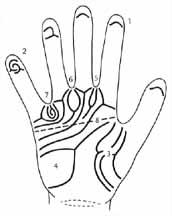
Phantom picture for the hand in Warkany syndrome:
Summary of most significant hand signs in Warkany syndrome:
- Hand level 5: clinodactyly of the 5th finger (pinky).
- Hand level 8: multiple arch fingerprints, often combined with one or a few whorls; the palm typically bares patterns in multiple interdigital regions (often present in all five zones: thenar/IDR I, IDR 2, IDR 3, IDR4 & hypothenar).
- Hand level 9: single palmar crease (= simian line).
More details on the hand in Warkany syndrome are available here:
» Phantom picture for the hand in Warkany syndrome
- 6 Deletion syndromes -
• [5]: 4p deletion syndrome (= Wolf-Hirschhorn syndrome):
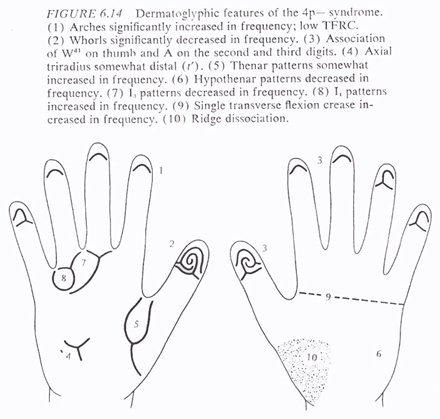
Phantom picture for the hand in Wolf-Hirschhorn syndrome.
Summary of the most significant hand signs in Wolf-Hirschhorn syndrome:
- Hand level 1: hand flapping.
- Hand level 5: clinodactyly of the 5th finger, tapering fingers (long & slender) [+ camptodactyly of the 4th finger].
- Hand level 7: hyperconvex nails.
- Hand level 8: arch fingerprints, low TFRC [+ ridge dissociation / hypoplastic dermal ridges].
- Hand level 9: single palmar crease (a.k.a simian line).
More details on the hand in Wolf-Hirschhorn syndrome available here:
» Phantom picture for the hand in Wolf-Hirschhorn syndrome
• [6]: 5p+/trisomy 5 syndrome (= cri-du-chat anti-syndrome):
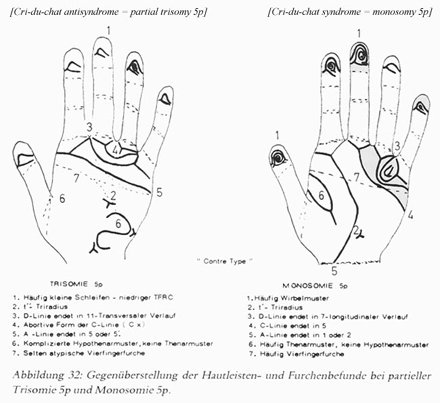
Phantom pictures for the hand in trisomy 5 syndrome & cri-du-chat anti-syndrome.
Summary of the most significant hand signs in trisomy 5/cri-du-chat anti-syndrome:
(Summary is in proces, available soon... most details are already displayed inside the table!)
More details on the hand in trisomy 5 syndrome available here:
» Phantom pictures for the hand in trisomy 5/cri-du-chat anti-syndrome
• [7]: 5p deletion syndrome (= cri-du-chat syndrome):
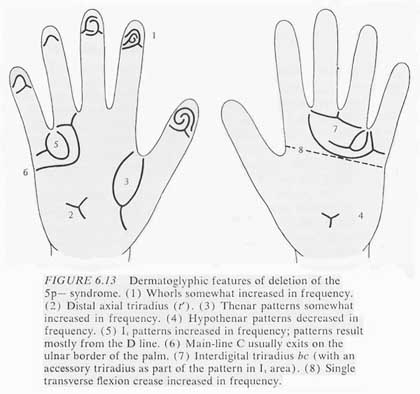
Phantom pictures for the hand in cri-du-chat syndrome.
Summary of the most significant hand signs in cri-du-chat syndrome:
- Hand level 4: slightly broad hands due to a short palm (3rd, 4th, and 5th metacarpals are typically disproportionately short).
- Hand level 8: the palm typically bares multiple patterns, ussually present in interdigital zone 4 + the thenar/interdigital zone 1; the A-line often ends in region 1 (radial side of the wrist).
- Hand level 9: single palmar crease (a.k.a simian crease), and quite often featured with a single interphalangeal crease on the fifth finger.
More details on the hand in cri-du-chat syndrome available here:
» Phantom pictures for the hand in cri-du-chat syndrome
• [8]: 15p deletion syndrome (= Prader-Willi syndrome):
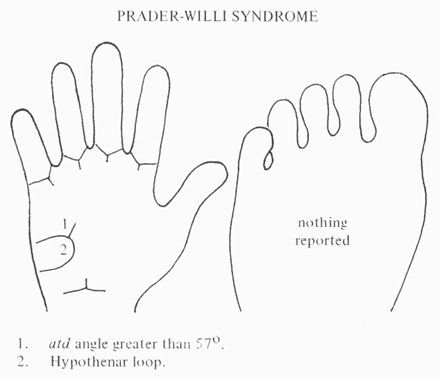
Phantom picture for the hand (& foot) in Prader-Willi syndrome.
Summary of the most significant hand signs in Prader-Willi syndrome:
- Hand level 3: small hands, narrow hands with straight ulnar border.
- Hand level 5: clinodactyly of the 5th finger and/or tapering fingers.
- Hand level 8: radial termination of main line A (or low termination in zone 1, 2 or 3).
More details on the hand in Prader-Willi syndrome are available here:
» Phantom picture for the hand in Prader-Willi syndrome
• [9]: 18p deletion syndrome (= de Grouchy syndrome 1):
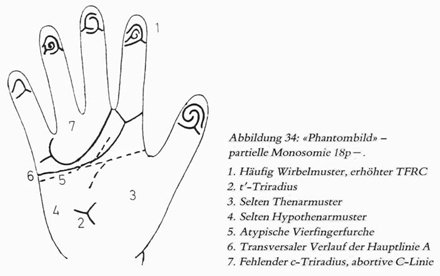
Phantom picture for the hand (& foot) in de Grouchy syndrome 1.
Summary of the most significant hand signs in Grouchy syndrome 1:
(Summary is in proces, available soon... most details are already displayed inside the table presented at the top of this article!)
More details on the hand in Grouchy syndrome 1 syndrome here:
» Phantom pictures for the hand in de Grouchy syndrome 1
• [10]: 18q deletion syndrome (= de Grouchy syndrome 2):
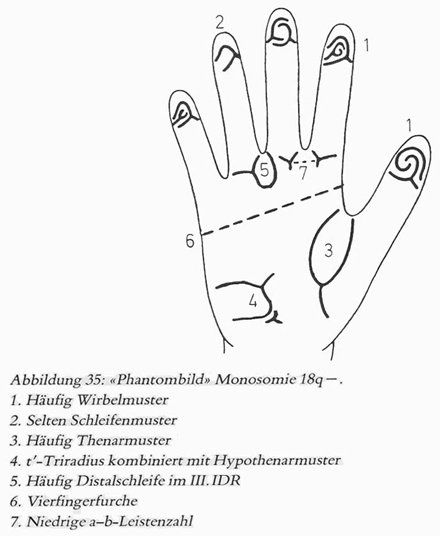
Phantom picture for the hand in de Grouchy syndrome 2.
Summary of the most significant hand signs in Grouchy syndrome 1:
(Summary is in proces, available soon... most details are already displayed inside the table presented at the top of this article!)
More details on the hand in Grouchy syndrome 2 syndrome here:
» Phantom pictures for the hand in de Grouchy syndrome 2
- 4 sex chromosome syndromes -
• [11]: XO = Turner syndrome:
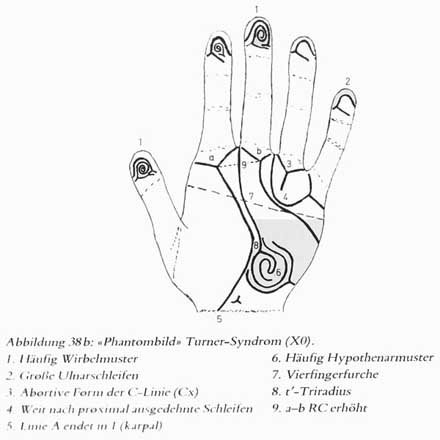
Phantom picture for the hand in Turner syndrome.
Summary of the most significant hand signs in Turner syndrome:
- Hand level 4: short 4th metacarpals; sometimes the 3rd, 4rd & 5th metacarpals are all disproportionately short.
- Hand level 7: fingernails are often small, narrow and may show overcurvature.
- Hand level 8: fingerprints tend to show high ridge count, e.g. large ulnar loops are most typical (extralimital triradii may also be present); the A-line often ends at the radial side of the wrist, palmar patterns are very common especially found on the hypothenar, the 3rd & 4th interdigital region) but the C-line is relatively often abbortive or the c-triradius may be missing.
More details on the hand in Turner syndrome are available here:
» Phantom pictures for the hand in Turner syndrome
• [12]: XYY = Jacobs syndrome:
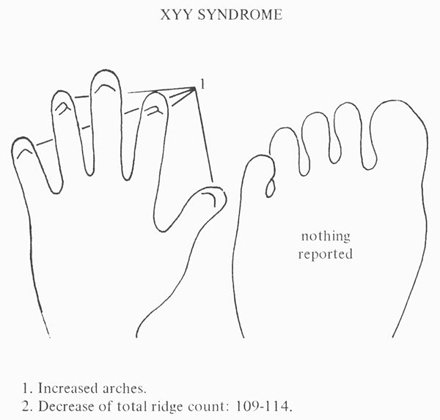
Phantom picture for the hand (& foot) in XYY syndrome.
Summary of the most significant hand signs in XYY syndrome:
- Hand level 2: (mild) tremors are very common and often impairs handwriting; weak muscle tone (hypotonia) or other involuntary movements (motor tics) are also often present.
- Hand level 5: clinodactyly involving the fifth finger is present in a majority of cases.
More details on the hand in XYY syndrome are available here:
» Phantom picture for the hand in XYY syndrome
• [13]: XXY = Klinefelter syndrome:
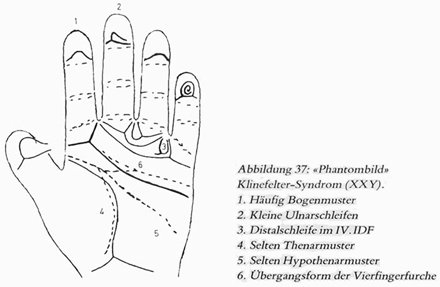
Typical hand characteristics in Klinefelter syndrome.
Summary of the most significant hand signs in Klinefelter syndrome:
- Hand level 2: tremors are not unusual.
- Hand level 3: small hands.
(- Hand level 5: a high 'female-like' 2d:4d digit ratio is also typical)
- Hand level 8: fingerprints tend to show low ridge count, e.g. smal ulnar loops often combined with arches are most typical and arches featured with a whorl in the same hand is also typical; in the palmar zone below the fingers a combination of patterns is often present resulting in a high number of digital triradii.
More details on the hand in Klinefelter syndrome are available here:
» Phantom pictures for the hand in Klinefelter syndrome
• [14]: XXYY = variation of Klinefelter syndrome:
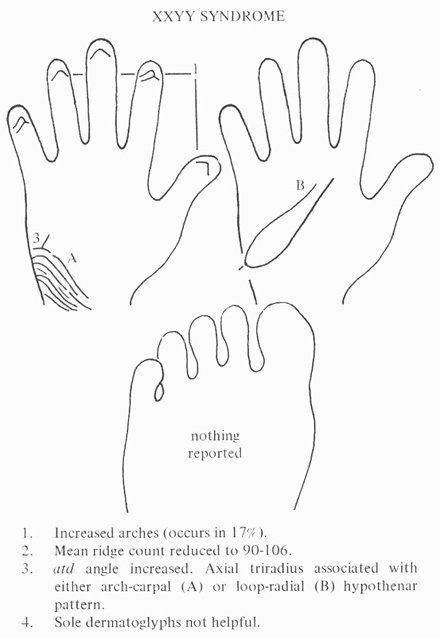
Phantom picture for the hand (& foot) in XXYY syndrome.
Summary of the most significant hand signs in XXYY syndrome:
- Hand level 2: tremors typically become manifest during adolescence and worsen with age; impaired handwriting is a typical symptom.
- Hand level 5: clinodactyly involving the fifth finger is recognized to belong to the most common physical features in prepubertal XXYY children.
- Hand level 8: a high postioned axial triradius is very often present and typically combined with either an arch-carpal- or loop-radial hypothenar pattern.
- Hand level 9: single palmar crease (a.k.a simian crease) is present in a minority of cases.
More details on the hand in XXYY syndrome are available here:
» Phantom picture for the hand in XXYY syndrome
- 12 Other syndromes -
• [15]: Acho = achondroplasia (the most common form of dwarfism):
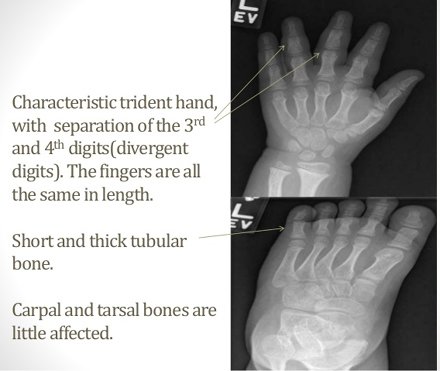
Trident hand in achondroplasia.
Summary of the most significant hand signs in achondroplasia:
- Hand level 2: trident hand (= inability to approximate extended middle and ring finger).
- Hand level 3: short & broad hand, resulting in very low hand index.
- Hand level 4: short & broad palm, all metacarpals are short.
- Hand level 8: the A-line often ends at the radial side of the wrist.
Details on the hand shape proportions in achondroplasia are described at the bottom of this article:
» Hand shape gives a clue about Genes, Chromosomes & DNA!
• [16]: AMC = arthrogryposis multiplex congenita:
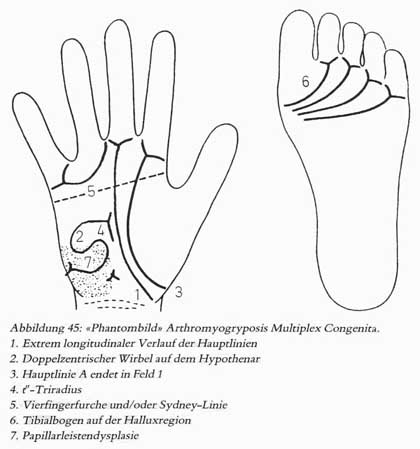
Typical hand characteristics in artrogryposis.
Summary of the most significant hand signs in arthrogryposis:
- Hand level 2: congenital joint contractures in two or more areas of the body, usually the hands are involved featured with fingers in fixed flexion and thumb in palm; major diagnostic criteria include also: camptodactyly or pseudocamptodactyly (limited passive proximal interphalangeal joint extension with hyperextension of the wrist), overriding fingers, and ulnar deviation at the wrist.
- Hand level 8: the dermatoglyphics in the palm typically show an extreme vertical alignment, the A-line often ends at the radial side of the wrist and all other main lines may show the same tendency; the hypothenar is typically featured with a complex pattern + a high positioned axial triradius (t").
- Hand level 9: single palmar creases and Sydney lines are seen in a large minority of cases; hypoplastic and/or absence of some interphalangeal flexion creases also belong to the major diagnostic criteria.
More details on the hand in arthrogryposis are available here:
» Phantom picture for the hand in arthrogryposis
• [17]: CdL-s = Cornelia de Lange syndrome:
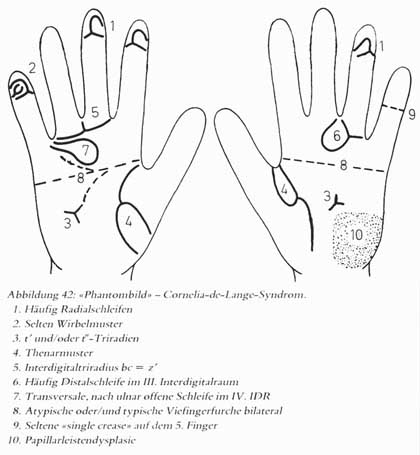
Phantom picture for the hand in Cornelia de Lange syndrome.
Summary of the most significant hand signs in Cornelia de Lange syndrome:
- Hand level 3: small hands (relative to body size).
- Hand level 5: clinodactyly of the 5th finger, short 5th finger (+ hypoplasia of the medial phalanx of the 5th finger).
- Hand level 8: radial loop fingerprints are very common (in a small majority on the index finger, and in large minority on the middle finger and/or ring finger); whorl fingerprints are even less common than arches. Regarding the dermatoglyphics in the palm, a combination of the following characteristics is often present: transversal loop in 4th IDR, distal loop in 3rd IDR, distal axial triradius t", thenar pattern.
- Hand level 9: single palmar creases are seen in a large minority of cases.
More details on the hand in Cornelia de Lange syndrome here:
» Phantom pictures for the hand in Cornelia de Lange syndrome
• [18]: FS-s = fetal alcohol syndrome:
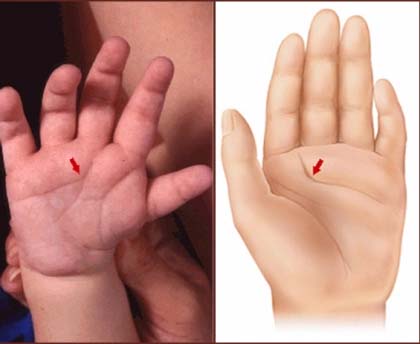
Fetal alcohol syndrome & the hockey-stick crease.
Summary of the most significant hand signs in fetal alcohol syndrome:
(Summary is in proces, available soon... most details are already displayed inside the table presented at the top of this article!)
More details on the hand in fetal alcohol syndrome here:
» Fetal alcohol syndrome & the hockey-stick crease
• [19]: Fra-X = fragile-X syndrome:
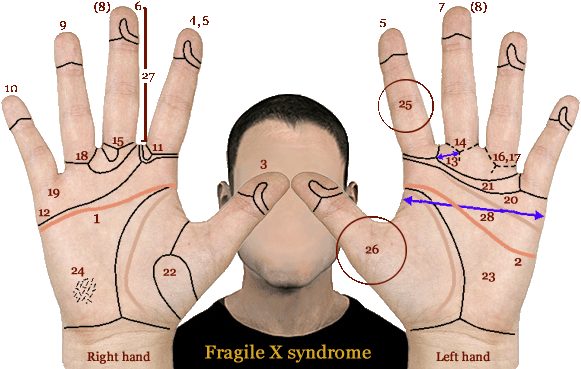
Phantom picture for the hand in fragile-X syndrome.
Summary of the most significant hand signs in fragile-X syndrome:
(Summary is in proces, available soon... most details are already displayed inside the table presented at the top of this article!)
More details on the hand in fragile-X syndrome here:
» Phantom pictures for the hand in fragile-X syndrome
» 36 Hand signs in fragile-X syndrome
• [20]: HO-s = Holt-Oram syndrome:
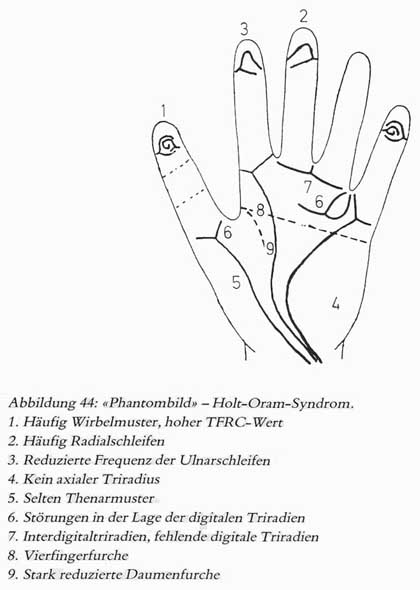
Phantom picture for the hand in Holt-Oram syndrome.
Summary of the most significant hand signs in fragile-X syndrome:
(Summary is in proces, available soon... most details are already displayed inside the table presented at the top of this article!)
More details on the hand in Holt-Oram syndrome here:
» Phantom picture for the hand in Holt-Oram syndrome
• [21]: KM-s = Kabuki make-up syndrome:
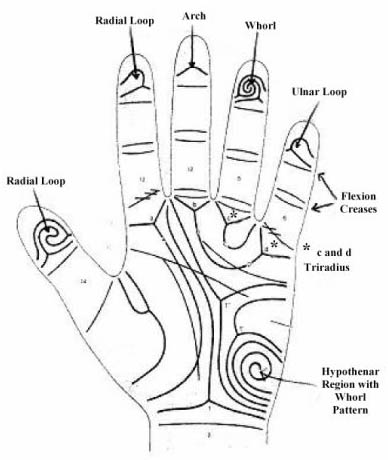
Phantom picture for the hand in Kabuki make-up syndrome.
Summary of the most significant hand signs in Kabuki make-up syndrome:
- Hand level 5: multiple abnormalities in the fifth finger are very common (such as: a very short finger, clinodactyly and/or an abnormally short middle phalange).
- Hand level 6: prominent volar pads are typical.
- Hand level 8: a radial loop or whorl in the hypothenar zone is very common; the A-line often ends at the radial side of the wrist; the c-triradius is often missing.
- Hand level 9: hypoplastic and/or absence of interphalangeal flexion creases on especially the 4th finger (and/or the 3th finger) represents also a typical feature.
More details on the hand in Kabuki make-up syndrome are available here:
» Phantom picture for the hand in Kabuki make-up syndrome
• [22]: M-s = Marfan syndrome:
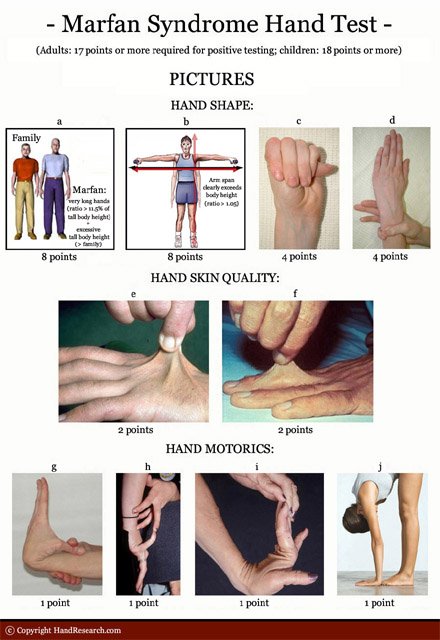
Phantom picture for the hand in Marfan syndrome.
Summary of the most significant hand signs in Marfan syndrome:
- Hand level 2: camptodactly (contractures in the fingers) & hyperextensible finger joints are often present.
- Hand level 3: long, large hands are typical.
- Hand level 5: arachnodactyly - a.k.a. spider-like fingers - is very often present, manifesting as a positive 'thumb sign' (= Steinberg sign) and/or a positive 'wrist sign' (= Walker-Murdoch sign); finger length is typically long relative to palm with (+ often also slightly long relative to palm length); tapering fingers are also often present.
- Hand level 7: hyperconvex / narrow nails [dolichonychia] is often present.
- Hand level 9: extra interphalangeal creases may be present.
More details on the hand in Marfan syndrome are available here:
» The Marfan syndrome hand test
• [23]: R-s = rubella syndrome:
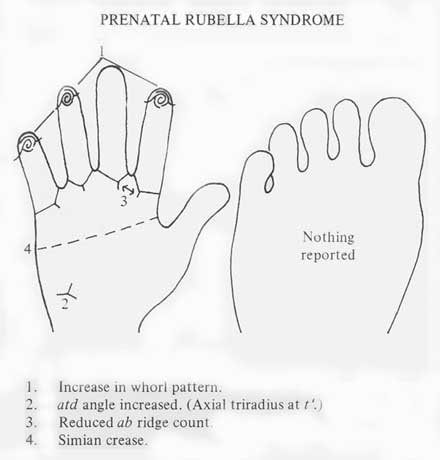
Phantom picture for the hand in Rubella syndrome.
Summary of the most significant hand signs in Rubella syndrome:
(Summary is in proces, available soon... most details are already displayed inside the table presented at the top of this article!)
More details on the hand in Rubella syndrome are available here:
» Phantom picture for the hand in rubella syndrome
• [24]: RT-s = Rubinstein-Taybi syndrome:
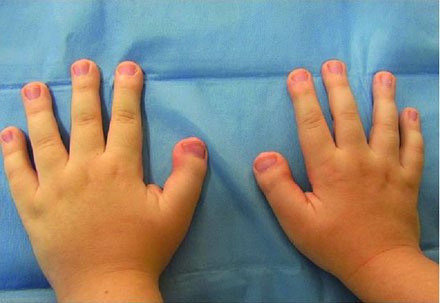
Hand impression for Rubinstein-Taybi syndrome: broad thumbs.
Summary of the most significant hand signs in Rubinstein-Taybi syndrome:
(Summary is in proces, available soon... most details are already displayed inside the table presented at the top of this article!)
More details on the hand in Rubinstein-Taybi syndrome are available here:
» (Not yet available)
• [25]: SLO-s = Smith-Lemli-Opitz syndrome:
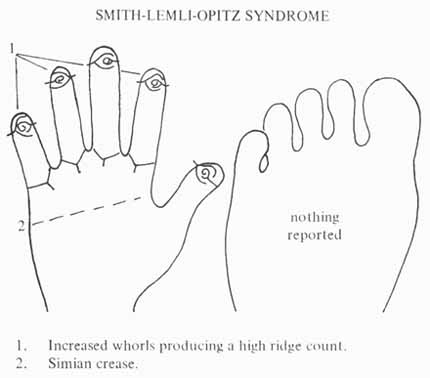
Phantom picture for the hand in Smith-Lemli-Opitz syndrome.
Summary of the most significant hand signs in Smith-Lemli-Opitz syndrome:
(Summary is in proces, available soon... most details are already displayed inside the table presented at the top of this article!)
More details on the hand in Smith-Lemli-Opitz syndrome are available here:
» Phantom picture for the hand in Smith-Lemli-Opitz syndrome
• [26]: W-s = Williams syndrome:
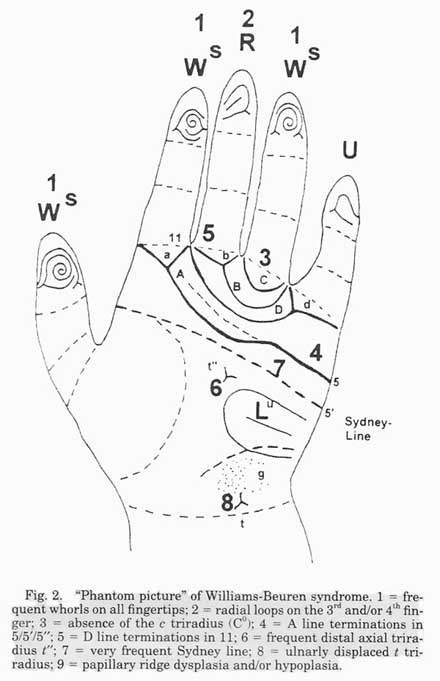
Phantom picture for the hand in Williams syndrome.
Summary of the most significant hand signs in Williams syndrome:
- Hand level 1: hand flapping is a common behavior seen in Williams syndrome.
- Hand level 4: short 4th and/or 5th metacarpals are common.
- Hand level 5: clinodactyly is very often present.
- Hand level 8: whorls on the 2nd fingers & radial loops on the hypotenar zone are common in the hypothenar zone is very common; D-line typically ends in region 11.
- Hand level 9: Sydney lines are present in a larg majority.
More details on the hand in Williams syndrome are available here:
» Phantom picture for the hand in Williams syndrome
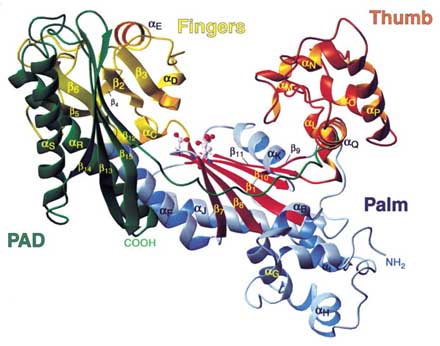
- 4 Medical disorders -
• [27]: Diab-M = diabetes mellitus:
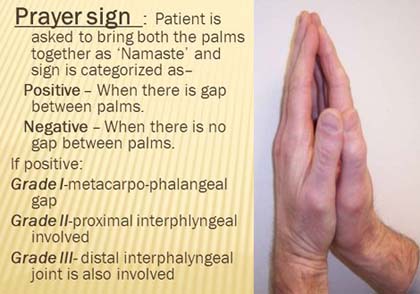
The hand in diabetes mellitus: the prayer sign.
Summary of the most significant hand signs in diabetes mellitus:
- Hand level 2: various problems involving hand motorics are often present; next to the 'diabetic hand syndrome' (a.k.a. 'limited joint mobility', which also involves loss of sensation), other typical manifestations can be: Dupuytren's contracture (involving the pinky or ring finger) & locked finger (a.k.a. 'trigger finger').
- Hand level 6: Thick, waxy/hardening skin on back of the hand (sclerodactyly) is very often present; dry scally palms and/or pink/shiny patches are also significant.
- Hand level 7: Terry's nails is quite often present in minority of cases; other abnormal color variations may also occure (e.g. blue lunulae, yellow nails + yellow skin, redness in proximal fold); onychomycosis (fungal infection of the nail) is also more common.
Details on the hand shape proportions in diabetes mellitus are available here:
» 35 Hand signs in diabetes mellitus
• [28]: HypC = hypercalcemia:
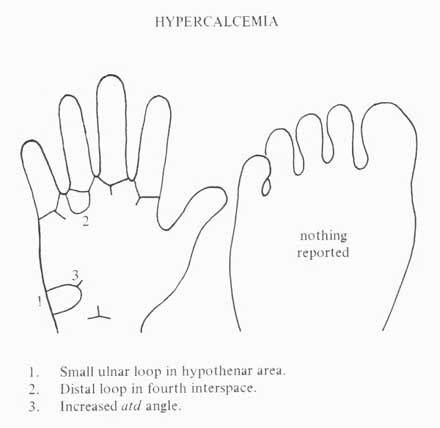
Phantom picture for the hand in hypercalcemia.
Summary of the most significant hand signs in hypercalcemia:
- Hand level 2: hand- or finger weakness (11%), arm cramps or spasms (11%) are strong predictors; hand tremors may also be present (especially in cases where hypercalcemia is the result of hyperthyroidism).
- Hand level 7: irregular appearing nails is recognized to represent a strong predictors.
- Hand level 8: combinations involving the following dermatoglyphic features bare potential to become significant: small hypothenar loop, distally shifted axial triradius (t'), high AtD angle, and distal loop in the fourth interdigital zone (ID4).
Details on the hand shape proportions in hypercalcemia are available here:
» Phantom picture for the hand in hypercalcemia
• [29]: Psor = psoriasis:
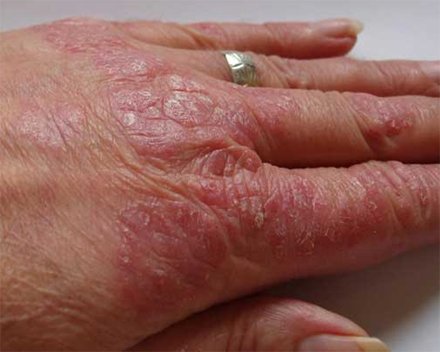
The hand in psoriasis: skin scales.
Summary of the most significant hand signs in psoriasis:
- Hand level 6: plaques represent the most characteristic feature in psoriasis (for decades, the area of one side of a flat closed patient's hand has been counted for 1% of his total body surface area filled with plaques). Epidermal thickening is another characteristic histologic finding of psoriasis lesions.
- Hand level 7: nail pitting (seen in above 70% with nail psoriasis) represents also a very characteristic finding - especially when large amounts of pits are presented featured with other nails disorders (such as onycholysis and/or horizontal ridging).
- Hand level 8: combinations involving the following dermatoglyphic features bare potential to become significant: small hypothenar loop, distally shifted axial triradius (t'), high AtD angle, and distal loop in the fourth interdigital zone (ID4).
More details on the hand in psoriasis are available here:
» 24 Hand signs in psoriasis
• [30]: Rheu-A = rheumatoid arthritis:
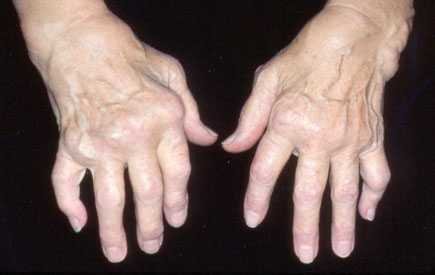
Hands affected with rheumatoid arthritis.
Summary of the most significant hand signs in rheumatoid arthritis:
(Summary is in proces, available soon... most details are already displayed inside the table presented at the top of this article!)
More details on the hand in rheumatoid arthritis are available here:
» 28 Hand signs in rheumatoid arthritis
- 2 Psychiatric disorders -
• [31]: ASD = autistic spectrum disorder:
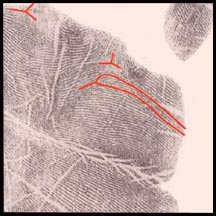
The hand in autistic spectrum disorder: unusual dermatoglyphics.
Summary of the most significant hand signs in autistic spectrum disorders:
- Hand level 1: hand flapping is a common behavior seen in autism.
- Hand level 5: clinodactyly is present in a very large minority, 2d:4d digit ratio is typically relatively small (0.94 to 0.95 in white males).
- Hand level 8: double loop fingerprints are relatively common (3x more common than controls); whorls, double loops or multiple loops are relatively common (3x more common than controls).
More details on the hand in autistic spectrum disorder are available here:
» Hand signs in autism
• [32]: Schiz = schizophrenia:
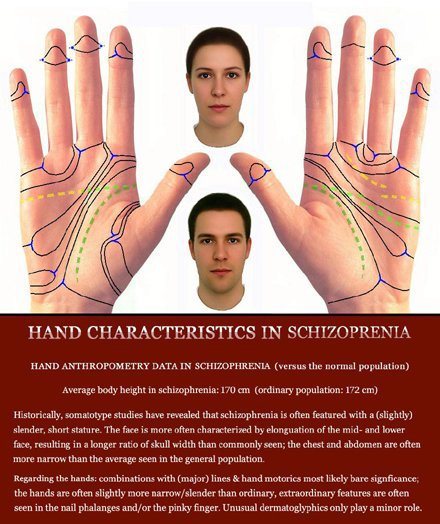
Phantom picture for the hand in schizophrenia.
Summary of the most significant hand signs in schizophrenia:
(Summary is in proces, available soon... most details are already displayed inside the table presented at the top of this article!)
More details on the hand in schizophrenia are available here:
» 47 Hand signs in schizophrenia
- The Big Five personality dimensions -
• [33]: A+ = high agreeableness (= agreeable):
IMPORTANT: The effect-size of individual hand signs associated with the Big Five personality dimensions is relatively small, and always much weaker than the largest effect-sizes seen in syndromes & disorders. This suggests that at best only a combination of hand features bares the potential to produce high significance, and this might even be typical for any aspect of personality!
Summary of the most significant hand signs in Agreeableness high scorers:
- Hand level 8: high pattern intensity, ID2 loop + high amount of digital triradii; hypothenar radial arch (+ hypothenar carpal arch or -whorl).
- Hand level 9: high radial termination of proximal crease; short proximal crease and/or long distal crease, Suwon crease remnant / extra-radial crease.
More details on the hand in the Big Five dimension Agreeableness are available here:
» Phantom Pictures for the Hand in Agreeableness & Antagonism: 4 hand factors!
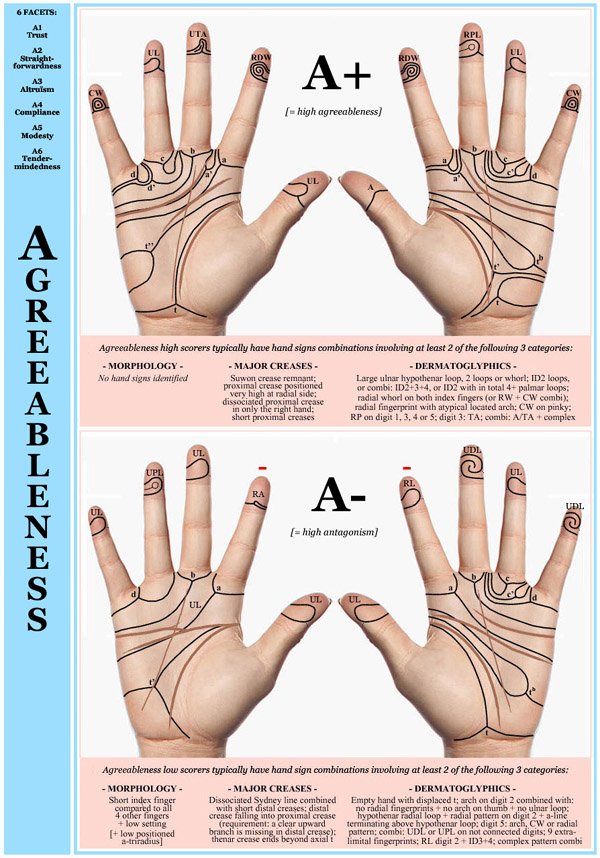
Phantom pictures for the hand in the Big Five personality dimension: Agreeableness (agreeable vs. antagonistic).
• [36]: A- = low agreeableness (= antagonism):
IMPORTANT: The effect-size of individual hand signs associated with the Big Five personality dimensions is relatively small, and always much weaker than the largest effect-sizes seen in syndromes & disorders. This suggests that at best only a combination of hand features bares the potential to produce high significance, and this might even be typical for any aspect of personality!
Summary of hand signs that bare the highest potential to become significant in Agreeableness low scorers:
- Hand level 8: 10 ulnar loop fingerprints and/or missing c-triradius.
- Hand level 9: simian line or dissociated Sydney line; short distal crease.
More details on the hand in the Big Five dimension Agreeableness are available here:
» Phantom Pictures for the Hand in Agreeableness & Antagonism: 4 hand factors!
• [35]: C+ = high conscientiousness (= conscientious):
IMPORTANT: The effect-size of individual hand signs associated with the Big Five personality dimensions is relatively small, and always much weaker than the largest effect-sizes seen in syndromes & disorders. This suggests that at best only a combination of hand features bares the potential to produce high significance, and this might even be typical for any aspect of personality!
Summary of the most significant hand signs in Conscientiousness high scorers:
- Hand level 3: low hand index.
- Hand level 5: high finger length to palm breadth ratio, tendency towards long distal phalanges + short proximal phalanges.
- Hand level 8: combinations involving the following dermatoglyphic features bare potential to become significant: large palmar triradial area, many non-radial small/arch related patterns, ulnar (tented) arch combined with ulnar loops, pocket loop on the middle finger.
- Hand level 9: combinations involving the following crease features bare potential to become significant: long proximal crease & distal crease combined, well developed mid-axis line with tendency to be located towards ulnar side.
More details on the hand in the Big Five dimension Conscientiousness are available here:
» Phantom Pictures for the Hand in Conscientiousness & Casualness: 4 hand factors!
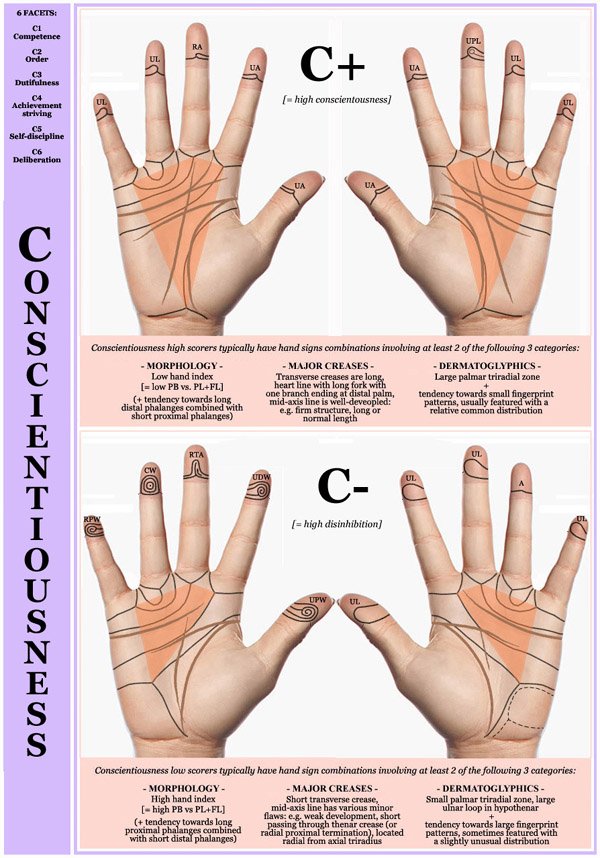
Phantom pictures for the hand in the Big Five personality dimension: Conscientiousness (conscientious vs. casual).
• [36]: C- = low conscientiousness (= casual):
IMPORTANT: The effect-size of individual hand signs associated with the Big Five personality dimensions is relatively small, and always much weaker than the largest effect-sizes seen in syndromes & disorders. This suggests that at best only a combination of hand features bares the potential to produce high significance, and this might even be typical for any aspect of personality!
Summary of hand signs that bare the highest potential to become significant in Conscientiousness low scorers:
- Hand level 3: high hand index.
- Hand level 5: low finger length to palm breadth ratio, tendency towards long proximal phalanges + short distal phalanges.
- Hand level 8: combinations involving the following dermatoglyphic features bare potential to become significant: small palmar triradial area, radial whorl-related fingerprint patterns with both triradii extralimital, large amount whorls and/or extralimital patterns, whorl- & arch combinations in 1 or both hands, unusual distribution of arch-related patterns.
- Hand level 9: combinations involving the following crease features bare potential to become significant: short proximal crease & distal crease combined, weak developed mid-axis line with tendency to be located towards radial side.
More details on the hand in Big Five dimension Conscientiousness are available here:
» Phantom Pictures for the Hand in Conscientiousness & Casualness: 4 hand factors!
• [37]: N+ = high neuroticism (= emotional sensitivity):
IMPORTANT: The effect-size of individual hand signs associated with the Big Five personality dimensions is relatively small, and always much weaker than the largest effect-sizes seen in syndromes & disorders. This suggests that at best only a combination of hand features bares the potential to produce high significance, and this might even be typical for any aspect of personality!
Summary of the most significant hand signs in Neuroticism high scorers:
- Hand level 5: (very) short pinky finger.
- Hand level 8: combinations involving the following dermatoglyphic features bare potential to become significant: (large concentric) whorls, missing of a c-triradius and/or total amount of interdigital triradii of just 3.
- Hand level 9: combinations involving the following crease features bare potential to become significant: extra interphalangeal creases, simian crease, reduced proximal crease & distal crease combined.
More details on the hand in the Big Five dimension Neuroticism are available here:
» Phantom Pictures for the Hand in Emotional stability & Neuroticism: 12 hand signs!
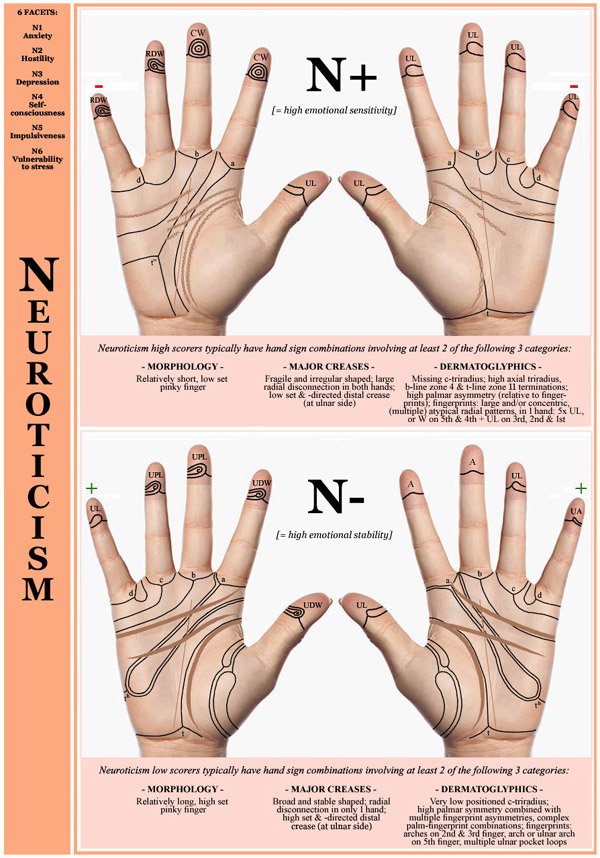
Phantom pictures for the hand in the Big Five personality dimension: Neuroticism (emotional sensitivity vs. emotional stability).
• [38]: N- = low neuroticism (= emotional stability):
IMPORTANT: The effect-size of individual hand signs associated with the Big Five personality dimensions is relatively small, and always much weaker than the largest effect-sizes seen in syndromes & disorders. This suggests that at best only a combination of hand features bares the potential to produce high significance, and this might even be typical for any aspect of personality!
Summary of hand signs that bare the highest potential to become significant in Neuroticism low scorers:
- Hand level 5: (very) long pinky finger.
- Hand level 8: combinations involving the following dermatoglyphic features bare potential to become significant: arch fingerprints, A-line does not end in region 1, total amount of interdigital triradii is at least 4, c-triradius is not missing.
- Hand level 9: combinations involving the following crease features bare potential to become significant: long proximal crease & distal crease combined.
More details on the hand in Big Five dimension Neuroticism are available here:
» Phantom Pictures for the Hand in Emotional stability & Neuroticism: 12 hand signs!
• [39]: E+ = high extraversion (= extraverted):
IMPORTANT: The effect-size of individual hand signs associated with the Big Five personality dimensions is relatively small, and always much weaker than the largest effect-sizes seen in syndromes & disorders. This suggests that at best only a combination of hand features bares the potential to produce high significance, and this might even be typical for any aspect of personality!
Summary of the most significant hand signs in Extraversion high scorers:
- Hand level 5: (slightly) short fingers relative to palm width bare potential to become significant.
- Hand level 8: combinations involving the following dermatoglyphic features bare potential to become significant: large long loop or whorl in the 4th IDR, whorl on the hypothenar zone, high amount of digital triradii, high amount of (small) ulnar loops, low a-b ridge count, and/or high positioned axial triradius.
More details on the hand in the Big Five dimension Extraversion are available here:
» Phantom Pictures for the Hand in Extraverts & Introverts: 7 hand signs!
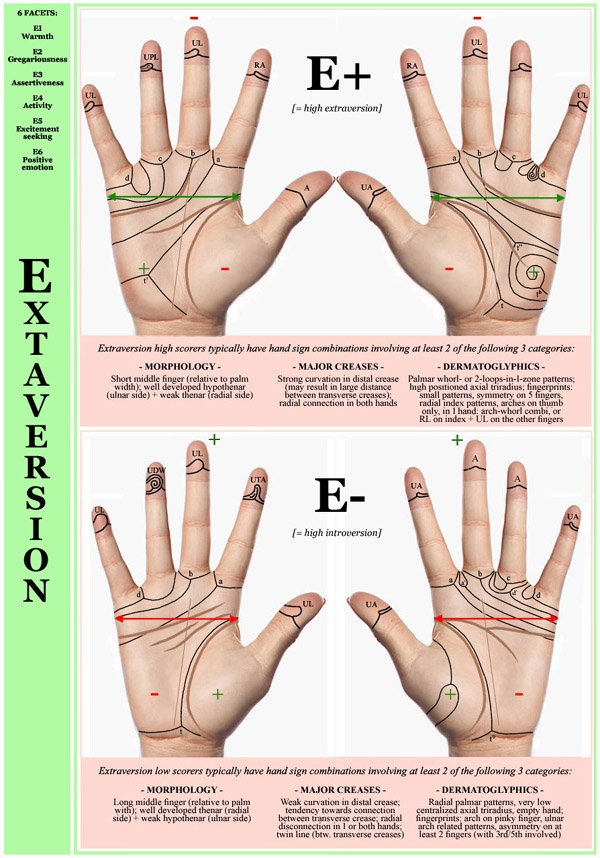
Phantom pictures for the hand in the Big Five personality dimension: Extraversion (Extraverted vs. Introverted).
• [40]: E- = low extraversion (= introverted):
IMPORTANT: The effect-size of individual hand signs associated with the Big Five personality dimensions is relatively small, and always much weaker than the largest effect-sizes seen in syndromes & disorders. This suggests that at best only a combination of hand features bares the potential to produce high significance, and this might even be typical for any aspect of personality!
Summary of hand signs that bare the highest potential to become significant in Extraversion low scorers:
- Hand level 5: (slightly) long fingers relative to palm width bare potential to become significant.
- Hand level 8: the combination of fingerprints & palm quite often displays a low total amount of triradii; it appears that combinations involving: (non-radial) arch fingerprints, missing of a c-triradius, total amount of interdigital triradii of just 3, and/or a missing- or very low positioned axial triradius, represent a typical dermatoglyphic constellation. A high a-b ridge count and a relatively high termination of the A-line represent other dermatoglyphic features that bare likewise potential to become significant.
- Hand level 9: a flat heart line or a constellation similar to a bridged simian line also bare potential to be significant.
More details on the hand in Big Five dimension Extraversion are available here:
» Phantom Pictures for the Hand in Extraverts & Introverts: 7 hand signs!
• [41]: O+ = high openness (= open):
IMPORTANT: The effect-size of individual hand signs associated with the Big Five personality dimensions is relatively small, and always much weaker than the largest effect-sizes seen in syndromes & disorders. This suggests that at best only a combination of hand features bares the potential to produce high significance, and this might even be typical for any aspect of personality!
Summary of the most significant hand signs in Openness high scorers:
- Hand level 5: clinodactyly of the pinky finger.
- Hand level 8: ID3 loops in both hands; a-line ends at region 1 (= radial side of wrist), d-line ends in region 1 (= between index- and middle finger).
- Hand level 9: large gap in proximal crease; dissociated proximal crease, especially in the left hand (+ high positioned axial triradius).
More details on the hand in the Big Five dimension Openness are available here:
» Phantom Pictures for the Hand in Openness & Closedness: 4 hand factors!
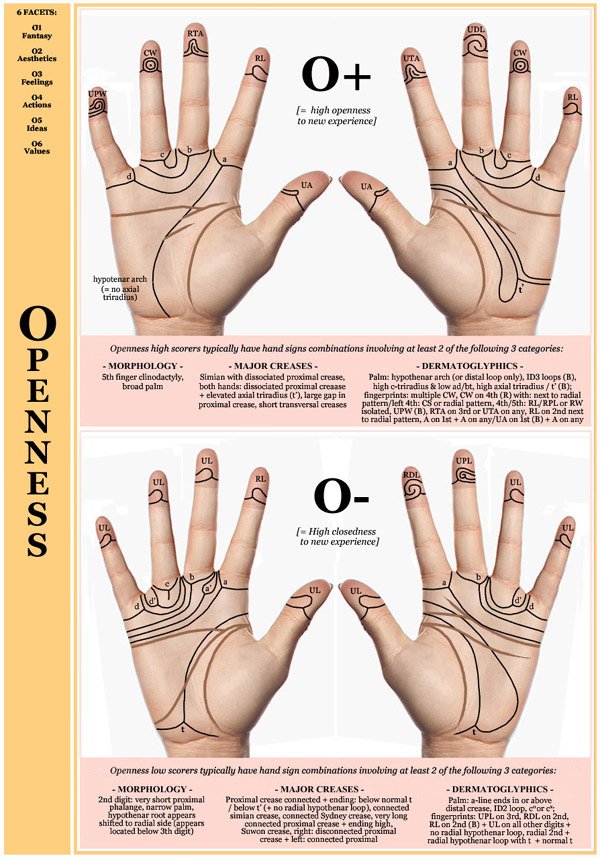
Phantom pictures for the hand in the Big Five personality dimension: Openness (open vs. closed).
• [42]: O- = low openness (= closed):
IMPORTANT: The effect-size of individual hand signs associated with the Big Five personality dimensions is relatively small, and always much weaker than the largest effect-sizes seen in syndromes & disorders. This suggests that at best only a combination of hand features bares the potential to produce high significance, and this might even be typical for any aspect of personality!
Summary of hand signs that bare the highest potential to become significant in Openness low scorers:
- Hand level 5: index finger has short proximal phalange.
- Hand level 8: complex hypothenar whorl; ID2 loop, A-line ends in region 5 (= near radial termation of distal crease), abortive c-line.
- Hand level 9: (connected) Sydney line, possibly combined with simian line; short transverse creases (combined with a short palm).
More details on the hand in the Big Five dimension Openness are available here:
» Phantom Pictures for the Hand in Openness & Closedness: 4 hand factors!

SUPPLEMENT: 56 Hand signs explained!
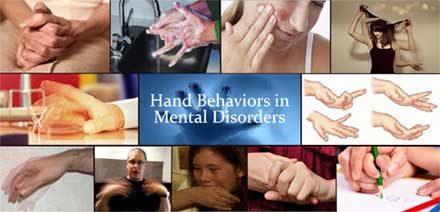
• HAND LEVEL 1 & 2 - behaviors & motorics
» Hand flapping (b): according the DSM 5 is hand flapping a common behavior assocated with Autims Spectrum Disorder [DSM 5 code: 299.00]. Hand flapping is also associated with various syndromes that often display autistic-type behaviors; fragile-x syndrome (Fra-X) is the most common & well-known example in this perspective.
» Camptodactyly / contractures (m): is itself a medical condition that causes one or more fingers to bent permanently, with the fifth finger always affected; anatomically this involves fixed flexion deformity of the proximal interphalangeal joints, which explains why camptodactyly became known as 'the syndrome of flexion contracture of the fingers'. Contractures involve a condition of shortening and hardening of muscles, tendons, or other tissue, often leading to deformity and rigidity of joints. Arthrogryposis (AMC) & Marfan syndrome (M-s) belong to the most common syndromes associated with this hand sign.
» Clenched hands (m): overlapping fingers concerns a medical condition that already becomes manifest before birth. This hand sign is very common in Edwards syndrom (Tr.18), Patau syndrome (Tr.13) and Smith-Lemli-Opitz syndrome (SLO-s).
» Hyperextensible finger joints (m): a.k.a. "double-jointedness" involves hypermobility of the finger joints. Down syndrome (Tr.21), Marfan syndrome (M-s) & rheumatoid arthritis (Rheu-A) are the most common conditions associated with this hand sign.
» Tremors (m): represent an unintentional, rhythmic muscle movement involving to-and-fro movements (oscillations) of one or more parts of the body. Most tremors occur in the hands; often, the tremor affects only the hand or fingers. Tremors play a role in quite a few syndromes (though not featured in this article, Parkinson's disease is the one moste often associated with tremor).
» Trident hand (m): this concerns a hand configuration that can be seen if the fingers are fully extended creating a separation between the middle and ring fingers featured with an inability to approximate both fingers; trident hands are most well-known for it's association with the most common cause of dwarfism: achondroplasia (Acho). The configuration is also associated with the so-called 'chondroplasias'.
» Other issues involving behaviors/motorics: conditions labelled in the table with 'yes' have other (often less common) issues for hand level 1 (hand behaviors) and/or hand level 2 (hand motorics).
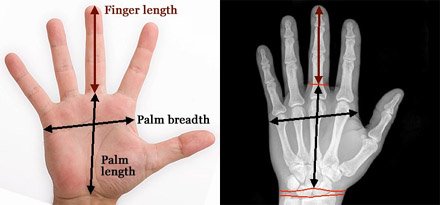
• HAND LEVEL 3 to 5 - morphology issues involving hand shape, palm shape & finger shape
» Hand index (h): this proportional dimenson concerns the ratio between hand width vs. hand lenght. Some syndromes have a high 'hand index' representing a relatively broad hand shape - e.g. achondroplasia (Acho) is typically featured with the most extreme proportions featured with a wide hand shape; while a few other syndromes typically have a low 'hand index' - e.g. Marfan syndrome (M-s) is often featured with the most extreme proporations featured with a narrow hand shape (+ likely also featured with a more narrow palm).
» Hand size (h): this proportional dimension requires an assessment relative to body height; syndromes featured with abnormal hand size usually show the tendency towards small hands; Marfan syndrome (M-s) represents one of the few exceptions not confirming this rule.
» Short metacarpals (p): occur in 10% of the general population and can be assessed through the knuckles when the hand is folded into a fist (with the fingers curled into the palm and the thumb retracted); short metacarpals occure in a variety of conditions, specific variations are often typical in various syndromes (e.g. short 4th metacarpals are most typical for Turner syndrome).
» Finger length (f): this proportional dimension requires an assessment relative to other body proportions, such as: palm width, palm length, or body height.
» 2D:4D digit ratio (f): this proportional dimension concerns the ratio between the absolute length of the index finger (= digit 2) vs. the ring finger (= digit 4), both are measured at the inner (palm) side of the hand from the tip of the finger to the proximal finger crease.
» Very short pinky finger (f): involves a pinky finger that does not reach beyond 3/4 the middle phalange of the ring finger (assessment is done with the interphalangeal creases).
» Archnodactly (f): a.k.a. 'spider fingers', is often described in terms of the combination of the 'thumb sign' & 'wrist sign'. The thumb sign (Steinberg's sign) is elicited by asking the patient to flex the thumb as far as possible and then close the fingers over it; a positive thumb sign is where part of the thumb is visible beyond the ulnar border of the hand, caused by a combination of hypermobility of the thumb as well as a thumb which is longer than usual. The wrist sign (Walker's sign) is elicited by asking the patient to curl the thumb and fingers of one hand around the other wrist; a positive wrist sign is where the little finger and the thumb overlap, caused by a combination of thin wrists and long fingers. Marfan syndrome is the most common condition associated with this hand sign.
» Clinodactyly (f): is a medical term describing the curvature of a finger in the plane of the palm, most commonly the fifth finger (the "little finger") towards the adjacent fourth finger (the "ring finger"). Clinodactyly is known to represent a very signficant hand sign in quite a few syndromes & disorders.
» Polydactyly [>5] & olichodactyly [<5](f): represent themselves a medical condition; polydactyly describes the presence of supernumerary fingers (at least 6 fingers are present, which is sometimes refered to as 'hyperdactyly'), and olichodactyly describes the missing of at least one finger (no more than 4 fingers are present). Each condition is more common than usual in some syndromes; Holt-Oram syndrome (HO-s) represent one of the very few syndromes where both conditions can be found (though not in the same person).
» Syndactyly (f): represents itself a medical condition (caused by genetic disorder involving the q loci of chromosome 2, 6 or 7), where two or more fingers are fused together; syndactyly plays a significant role in multiple syndromes.
» Tapering fingers (f): are defined as long fingers that gradually become narrower. Of itself tapering fingers represent a minor malformation and may be of no clinical significance, but this hand sign also does have an association with various syndromes & disorders - Marfan syndrome (M-s) represent the most common example.
» Other morphology particularities: conditions labelled in the table with 'yes' have other (often less common) issues for hand level 3 (hand shap) and/or hand level 4 (palm shape), or hand level 5 (finger shape).
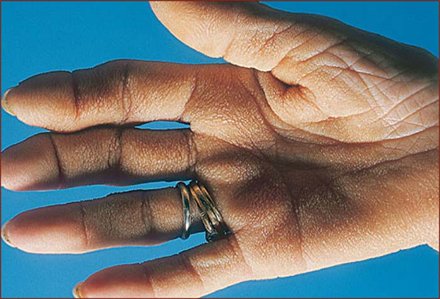
• HAND LEVEL 6 - skin
» Plaques: are solid, raised, flat-topped lesions greater than 1 cm. in diameter, most well-known for it's manifestation in psoriasis (Psor) - where it typically involves patches of rough, red skin and silvery-white scales.
» Prominent volar pads: a.k.a. 'fetal pads', are fleshy pads at the tips of the fingers; the 'volar pads' normally occur in human fetuses, in most people they disappear before birth. These finger pads are known to represent a major diagnostic sign in Kabuki make-up syndrome (KM-s).
» Thickening: a.k.a. palmar 'scleroderma' (hardening of the skin) or 'hyperkeratosis' of the skin (thickening of the outermost layer of the epidermis) - often present in medical disorders such as psoriasis and diabetes mellitus. NOTICE: both 'scleroderma' and 'hyperkeratosis' represents themselves medical conditions that should be discriminated from relatively normal 'caluses', where the hardening on parts of the skin manifests in response to repeated friction, pressure, or other irritation - which is especially often seen in fragile-X syndrome (Fra-X).
» Other skin particularities: conditions labelled in the table with 'yes' have other (often less common) issues for hand level 6.
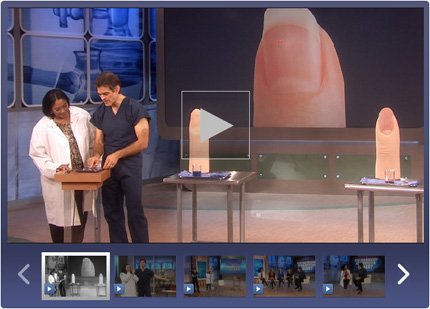
• HAND LEVEL 7 - fingernails
» Hypoplastic nails: involves underdeveloped- or missing fingernails. This represents itself a medical condition which has associations with many syndromes, especially with most trisomy syndromes.
» Pitting: involves pinhead-sized depressions in the nail plate. Large amounts of pits are very significant for psoriasis (Psor).
» Terry's nails: involves the color distribution: half white, half pink - the nails appear white with a characteristic "ground glass" appearance, with no lunula (Psor).
» Small, short nails: significant if present in all (or most) fingernails. Significant for various syndromes, occasionally also reported to bare significance for schizophrenia (Schiz).
» Hyperconvex / narrow nails: a.k.a. 'dolichonychia', referring to elongated, slender nails. Very significant in Marfan syndrome (M-s), also in Turner syndrome (XO).
» Other nail particularities: conditions labelled in the table with 'yes' have other (often less common) issues for hand level 7.
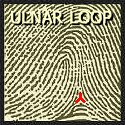
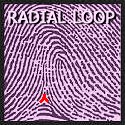
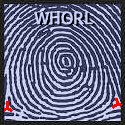
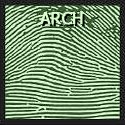
• HAND LEVEL 8a - fingerprint patterns
» Ulnar loops: this fingerprint pattern type is most significant for Down syndrome (Tr.21), where a large majority has 10 ulnar loops (= the most common variant of monomorphic hands).
» Radial loops: the distribution of radial loops among the individual fingers varies significantly in quite a few syndromes.
» Whorls: the prevalence and/or distribution of whorls among the indiviual fingers varies in especially many syndromes.
» Arches: the prevalence and/or distribution of arches among the indiviual fingers varies especially in many syndromes; in Edwards syndrome (Tri.18) arches are very often present on all 10 fingertips, very high prevalence is also often present in Patau syndrome (Tr.13) & Warkany syndrome (Tr.8).
» Total finger ridge count [TFRC]: ridge count this involves the amount of ridges that is present in a fingerprint between the core and the triradius (if present); TFRC is the summary of ridge count in all 10 fingers.
» Other fingerprint particularities: conditions labelled in the table with 'yes' have other (often less common) issues for hand level 8a.
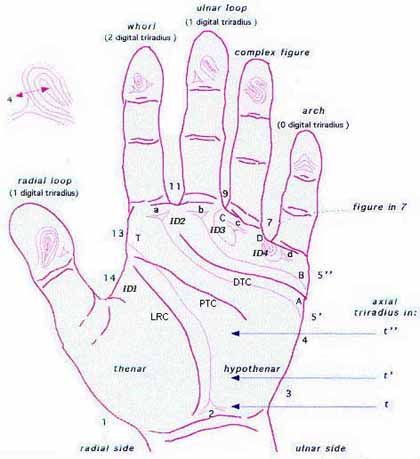
• HAND LEVEL 8b - palmar dermatoglyhic patterns
» Hypothenar: in the normal population this zone often only has a low positioned triradius located not far away form the center of the wrist [see picture above]. However, in many conditions this zone does show more often a tendency to bare a loop, whorl or a combination - often featured with one or more extra triradii; there are also some conditions where hypothenar patterns are even more rare than in the normal populaton.
» Thenar / Ist IDR: in the normal population this zone usually does not bare a pattern, nor a triradius [see picture above]. However, in a wide range of conditions this zone does show more often a tendency to bare one of more patterns - usually one or two loops with accessory triradi; there are also some conditions where thenar patterns are even more rare than in the normal populaton.
» 2nd IDR: in the normal population the 2nd interdigital region usually does not have a pattern [see picture above]. Only in some conditions this zone does show more often a tendency to bare one of more patterns; there are also some conditions where ID2 patterns are even more rare than in the normal populaton.
» 3rd IDR: in the normal population it is not unusual for the 3rd interdigital region to have a loop [in the picture above the 3rd IDR does have a loop]. In quite a few conditions this zone does show more often a tendency to bare a loop; only in just couple of conditions where ID3 patterns are even more rare than in the normal populaton.
» 4th IDR: in the normal population it is normal for this zone to have a loop [picture above does have a loop in the 4th IDR]. Only in a few conditions this zone does show very often a tendency to bare a loop; in a few conditions ID4 patterns are even more rare than in the normal populaton.
» A-B ridge count: this involves the amount of ridges between the a-triradius (located below the index finger) and the b-triradius (located below the middle finger) - only the triradii are displayed in the picture above.
» Digital triradii: in the normal population the palmar zone below the fingers typically has just one triradius located below each finger, featured with just one loop [in the picture above there is also an extra triradius d' displayed, featured with a 2nd loop]. Various conditions often have more triradii in this zone, and in some other conditions especially below the ring finger the c-triradius may be missing.
» Zygodactyly triradii: involves the fusion of two triradii combined with other features in the dermatoglyphics which suggest that something unusual manifests; a fusion of triradii c & d is described as z', and a fusion of triradii b & c is described as z". Only a few syndromes have been associated with a zygodactylous triradius.
» Axial triradii: involves the amount of triradii found on the hypothenar zone [in the picture above there is only 1 axial triradius displayed: t]. Only in a few syndromes it is very common to see multiple triradii on the hypothenar.
» t': refers to a slightly high axial triradius located in the 2nd quarter of the hypothenar zone - which refers to the upper quarter in the lower half of the zone between the wrist van the ulnar part of the distal transverse crease (= heart line) [see picture above]. In a wide range of conditions it is normal to see t'.
» t": refers to a high positioned axial triradius located in the 3rd quarter of the hypothenar zone - which refers to the lower quarter in the upper half of the zone between the wrist van the ulnar part of the distal transverse crease (= heart line) [see picture above]. In a wide range of syndromes & medical disorders it is normal to see t'.
» AtD angle: involves the angle between the a- triradius (located in the palm the index finger), the axial triradius (usually located near the center of the wrist), and the d-triradius (located in the palm below the pinky finger); in the general population AtD-angle typically varies between 30 and 65 degrees. In a wide range of syndromes & medical disorders it is normal to see t".
» A-line ends in region 5: dermatoglyphic ridge line starting from the a-triradius below the index finger ends at the ulnar side in the upper half of the palm [see picture above]; especially in the right hand variantion 5' is by far the most common variation in the general population (variation 5" is far less common). In quite a few syndromes the variations 5' & 5" are more common than in the general population, but in some other syndromes the prevalence is less common.
» A-line ends in region 1: dermatoglyphic ridge line starting from the a-triradius below the index finger ends at the radial side of the wrist [not visible in picture above]; especially in the right hand is variation 1 quite rare. In quite a few syndromes variation 1 is much more common than in the general population, but in some other syndromes the prevalence is less common.
» C-line is missing (= missing c triradius): involves the absence of the c-triradius below the ring finger [not visible in picture above]. In quite a few syndromes a missing C-line is more common than in the general population.
» C-line is abortive:: involves an abruptive ending of the ridge line starting in the triradius below the ring finger and ending in that zone as well [not visible in picture above]. In some syndromes this variation is more common than in the general population, but in cri-du-chat syndrome (5p-) this variation is less common.
» D-line ends in region 7: dermatoglyphic ridge line starting from the a-triradius below the index finger ends at the distal part of the palm between the ring finger & pinky [see picture above]. In a few conditions this variation is more common than in the general populatoin, especially in cri-du-chat syndrome (5p-).
» D-line ends in region 11: dermatoglyphic ridge line starting from the a-triradius below the index finger ends at the distal part of the palm between the ring finger and pinky [not visible in picture above]. In quite a few syndromes this variation is more common than in the general population, but there are also some syndromes where this variations is less common.
» Pattern intensity: involves the amount of patterns (loop or whorls) found in the palm [in the picture above this amount = 2]. In some syndromes the pattern intensity is higher than in de normal population, but in some other syndromes the pattern intensity is lower.
» Other palmar dermatoglyphic particularities: conditions labelled in the table with 'yes' have other (often less common) issues for hand level 8b.
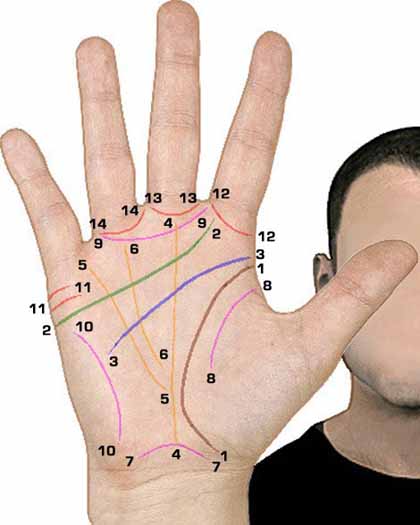
• HAND LEVEL 9 - crease system (= hand lines)
» Missing interphalangeal creases: there is only one interphalangeal crease instead of the normal two (usually without abnormalities of the bones and joints or evidence of dyskinesia). Usually a missing interphalangeal crease is found in the fifth finger (pinky finger) - most commonly observed in Down syndrome (Tr.21) & Edwards syndrome (Tr.18); Kabuki make-up syndrome (KM-s) is the only syndrome where this hand sign is typically associated with the 3rd and 4th fingers.
» Extra interphalangeal creases: this hand sign has a strong association with Marfan syndrome (M-s).
» Single palmar crease: in palmistry a.k.a. the 'simian line'; all sorts of conditions show a high prevalence for this hand sign.
» Sydney line: this hand sign became known for it's significance in Down syndrome (Tr.21), but by far the highest prevalence for the Sydney line is found in Williams syndrome (W-s).
» Hockey stick crease: this hand sign is especially known for it's high prevalence in fetal alcohol syndrome (FA-S), and also in CHARGE syndrome (NOTICE: the latter condition falls beyond the contents of this article).
» Reduced proximal crease (head line): this hand sign is especially known for it's significance in in fetal alcohol syndrome (FA-S).
» Reduced distal crease (heart line): this hand sign is especially known for it's significance in in fetal alcohol syndrome (FA-S) & Holt-Oram syndrome (HO-s).
» Other crease particularities: conditions labelled in the table with 'yes' have other (often less common) issues for hand level 9.
The next major section involves a presentation of hand charts; these 'phantom pictures' summarize the most typical hand signs for a specific condition (usually involving a syndrome or disease):
